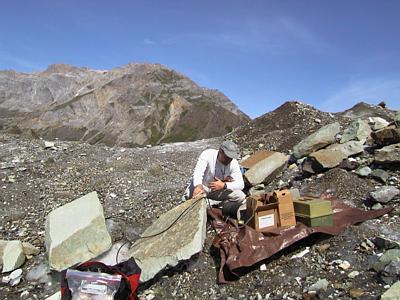17 July, 1999
July 17
Today there was much interest in monitoring the lake as it finished
draining. While breakfasting at camp this morning, Bob Anderson
(Geomorphologist from UC Santa Cruz) flew over in an airplane to take aerial
photographs of the lake. Surveyor Dennis Trabant (USGS from Fairbanks) was
up and at the surveying monument early. This is a critical stage for
surveying. The glacier in the vicinity of the lake is going through
significant topographic changes as the drain/flood continues. Dennis needs
to capture these position changes in order to further understand the
response of the floating portion of the glacier to the changing lake level.
After breakfast I made my way up to the survey site. Dennis was surveying.
PI Joe Walder reported from the lake that the level had dropped 30 meters
(~100 feet) since yesterday morning. Little of the lake remained. Surface
water was barely visible. Icebergs were stranded throughout the lake basin.
The larger of these were breaking apart, generating loud rumblings.
Booming noises filled the air as blocks of ice calved from the margin of the
glacier and into the lake. Seismologist Steve Malone arrived to watch the
show. "Oohs", and "Ahs", and "Whoa! Look at that", dribbled from our
voices. The scene exceeded the best of any fireworks show I had ever
observed.
Grad student Don Lindsay and driller Joel Harper hiked out to the borehole
to transfer data from the borehole pressure transducer to the computer. The
data suggested that water level in the hole had come up during the night and
had started to drop. It was too early to interpret what these data meant.
Now that the drilling was finished, Joel Harper was going to head for home.
This was his third project on a glacier this summer. He has had a long
summer of work in the field. When I walked down from the survey site I saw
him walk over the adjacent rise. He was hiking to the Foss airstrip,
located about a mile and a half to the north of our camp. Seismologist
Steve Malone is also leaving today. I will be monitoring his seismometers
for the next few days.
By the end of the day PI Andrew Fountain (Portland State University) was
giddy - enthusiastic about the outcome of the project. No one had ever
measured an outburst flood from the source to the discharge before. He
thanked us all for our hard work. The early flooding inconvenienced the
collection of an extensive data set. However, data from each of the aspects
of the study was successfully collected. We stood around the camp table and
raised our glasses (plastic cups actually - they did not "chink" very well
at the tap of the rim) to a successful and eventful effort.
_______________________________________________________________
Get Free Email and Do More On The Web. Visit http://www.msn.com

TEA Robert Schlichting checks the seismograph. The seismograph is being used to monitor ice-quakes before, during, and after the outburst flood.
Contact the TEA in the field at
.
If you cannot connect through your browser, copy the
TEA's e-mail address in the "To:" line of
your favorite e-mail package.
|
